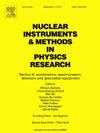Development of a setup for precision measurement of the time parameters of thin-walled straw tubes for the COMET experiment
IF 1.5
3区 物理与天体物理
Q3 INSTRUMENTS & INSTRUMENTATION
Nuclear Instruments & Methods in Physics Research Section A-accelerators Spectrometers Detectors and Associated Equipment
Pub Date : 2025-04-11
DOI:10.1016/j.nima.2025.170530
引用次数: 0
Abstract
COMET (Coherent Muon to Electron Transition) is an experiment designed to search for the process of the neutrinoless, coherent transition of a muon to an electron in an aluminum atom, which will be implemented using the proton beam of the J-PARC accelerator complex, Japan. One of the main detectors of the COMET experiment is a straw tracker made of thin-walled drift tubes. A straw tube is a single-channel gas drift tube, the time parameters of which will determine the accuracy of measuring the momentum of a 105 MeV electron in the experiment. To study the time characteristics of thin-walled (12 μm) aluminized straw tubes with a diameter of 5 mm, a precision measurement system was developed and measurements of the time resolution, drift velocity, nonlinearity of the parameters over the cross-section were performed, the R-T dependence for the Ar/CO2 (60/40) pre-mixed gas mixture was obtained. This setup also allows studying the time parameters for other gas mixtures.
研制了用于彗星实验的薄壁吸管管时间参数精确测量装置
彗星(相干μ子到电子跃迁)是一个旨在寻找铝原子中μ子到电子的无中微子相干跃迁过程的实验,该实验将使用日本J-PARC加速器综合体的质子束来实现。彗星实验的主要探测器之一是由薄壁漂移管制成的吸管追踪器。吸管管是一种单通道气体漂移管,其时间参数将决定实验中测量105mev电子动量的精度。为了研究直径为5 mm的12 μm薄壁镀铝吸管管的时间特性,研制了精密测量系统,测量了时间分辨率、漂移速度、各参数在截面上的非线性以及Ar/CO2(60/40)预混合气体混合物的R-T依赖关系。这种设置也允许研究其他气体混合物的时间参数。
本文章由计算机程序翻译,如有差异,请以英文原文为准。
求助全文
约1分钟内获得全文
求助全文
来源期刊
CiteScore
3.20
自引率
21.40%
发文量
787
审稿时长
1 months
期刊介绍:
Section A of Nuclear Instruments and Methods in Physics Research publishes papers on design, manufacturing and performance of scientific instruments with an emphasis on large scale facilities. This includes the development of particle accelerators, ion sources, beam transport systems and target arrangements as well as the use of secondary phenomena such as synchrotron radiation and free electron lasers. It also includes all types of instrumentation for the detection and spectrometry of radiations from high energy processes and nuclear decays, as well as instrumentation for experiments at nuclear reactors. Specialized electronics for nuclear and other types of spectrometry as well as computerization of measurements and control systems in this area also find their place in the A section.
Theoretical as well as experimental papers are accepted.

 求助内容:
求助内容: 应助结果提醒方式:
应助结果提醒方式:


